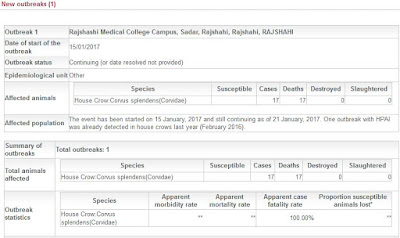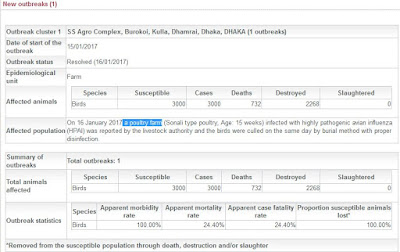#12,147
While once a major hotbed of H5N1 activity, including the detection of 8 human cases, reports have become far more sporadic from Bangladesh over the past few years with only one outbreak reported in all of 2016.
Today, however, the OIE has been notified for two different January outbreaks, roughly 200km apart. The first involves crows at the Rajshashi Medical College Campus, while the second was at a poultry farm in Dhaka.
While waterfowl (ducks & geese) and gallinaceous birds (turkeys, grouse, chickens & quail) are most often associated with carriage of HPAI H5 viruses, terrestrial birds such as crows, starlings, pigeons, and sparrows are also known to carry, and shed, theses viruses as well (see 2007’s EID Journal Role of Terrestrial Wild Birds in Ecology of Influenza A Virus (H5N1).
As far back as 2008, we saw reports out of India of crows dying from the H5N1 virus. In 2012, and again in 2014 India saw numerous wild bird die offs that were blamed on the avian flu virus (see Media Report: H5N1 Killing Crows In Jharkhand).
With the emergence of new avian flu subtypes, clades, and genotypes around the globe nearly every year, research into their interactions with thousands of non-aquatic bird species has only just begun. And with the seemingly greater transmissibility of clade 2.3.4.4. H5 viruses among migratory birds in both Europe and Asia, the need for additional study and surveillance is all the greater.


